Henry Avery earned his fame by pulling off what is considered the most profitable pirate heist of all time and being one of the rare pirate captains who retired with his loot. Most of the others were killed in battle or executed after their arrest. Avery used multiple different aliases during his career. The one that he used most often is Benjamin Bridgeman “Long Ben”. He also earned many different nicknames from his contemporaries. The best known of these are “The King of Pirates” and ”The Arch Pirate”.
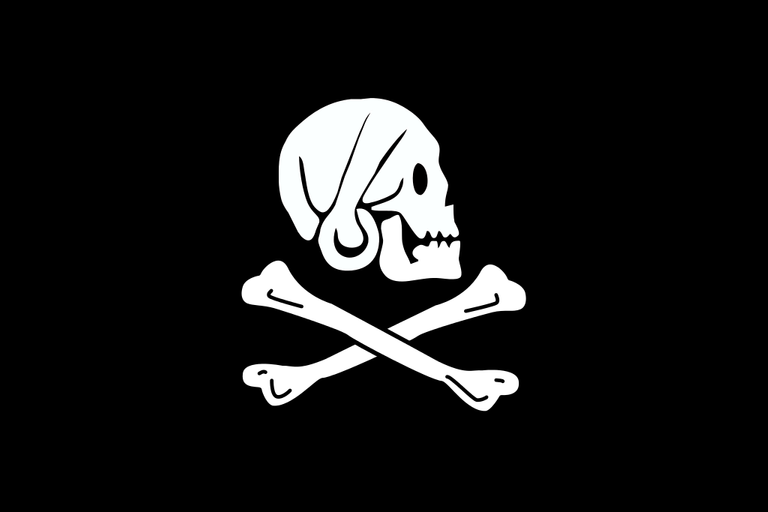
Depiction of Henry Avery’s Jolly Roger. This flag is based on the description that first surfaced in the 1920s. There is no reliable evidence that his flag looked like this but it is one of the versions based on stories about The Arch Pirate.
Life before piracy
Henry Avery was born in 1659 in Newton Ferrers in southwest England. He probably became a sailor as a youth, but the first official record of him being at the sea comes from March 1689, a little after the breakout of the Nine Years’ War. He was serving in the Royal Navy as a midshipman (officer of the junior-most rank) on the battleship with sixty-four canons HMS Rupert. Before getting discharged from the navy in late August 1690, he was promoted to the rank of Master’s mate (Sub-Lieutenant in the modern navy) in July 1689.
In 1690 Avery started slave trading under the protection of governor of the Bahamas. He was notorious for enslaving slave traders themselves and selling them along with their former slaves.
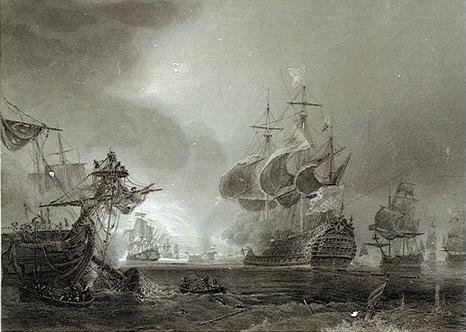
Battle of Beachy Head (1690) - The battle in which Henry Avery probably participated while he was serving in the Royal Navy - Steel engraving by Théodore Gudin
In spring of 1693, Henry Avery was recruited by Sir James Houblon as the first mate on the frigate Charles II. The frigate was a part of Spanish Expedition Shipping, a venture which consisted of four warships. The venture was conducting three different lines of business. One of those was supplying the Spanish with arms. They were also recovering treasure from wrecked ships they found. The third and the most important business they were conducting was the plundering the French by the commission Charles II of Spain.
In August 1693, the ships were sailing to the city of Corunna. They arrived there a few months late and upon their arrival, they encountered another problem. Legal documents for the ships didn’t arrive from Madrid and they were forced to stay in the port. Months were passing by and sailors weren’t receiving their wages. This is the situation which led to Avery turning into a pirate. Try to imagine the situation; the ship is staying in the port, sailors are receiving no wages and they have no money to send to their families; the captain is in position where he can’t give them money as there would be nothing that would keep them from leaving their employment once they received the money.
In early May 1694, the sailors started planning the mutiny. Due to his experience, Henry Avery was in command of the mutiny. He was going from ship to ship and persuading men to join him, telling them that there were immense riches to be acquired on the Spanish coast if they ran away with the ship
The Pirate Round
On 7 May, Admiral O’Byrne was scheduled to sleep ashore, and mutineers decided to strike. Captain Gibson of the Charles II was known as a man who loved his bottle, and he was bedridden when Avery with twenty-five other men surprised the crew of the ship and silently took it under their control. Sixteen more men from the James also joined the mutiny by coming on the side of the ship in a longboat and giving the watchword to Avery’s men: “Is the drunken boatswain on board?”. After the men joined the mutineers aboard, Avery softly weighed anchor and went to the open sea without much noise. When the authorities in the port realized what has happened, they offered a considerable reward to go in pursuit of the Charles II. The only ship in the port powerful enough to challenge the Charles II was a Dutch vessel with forty guns, but the captain of the ship refused the offers and Avery’s crew was free to sail with no pursuers.
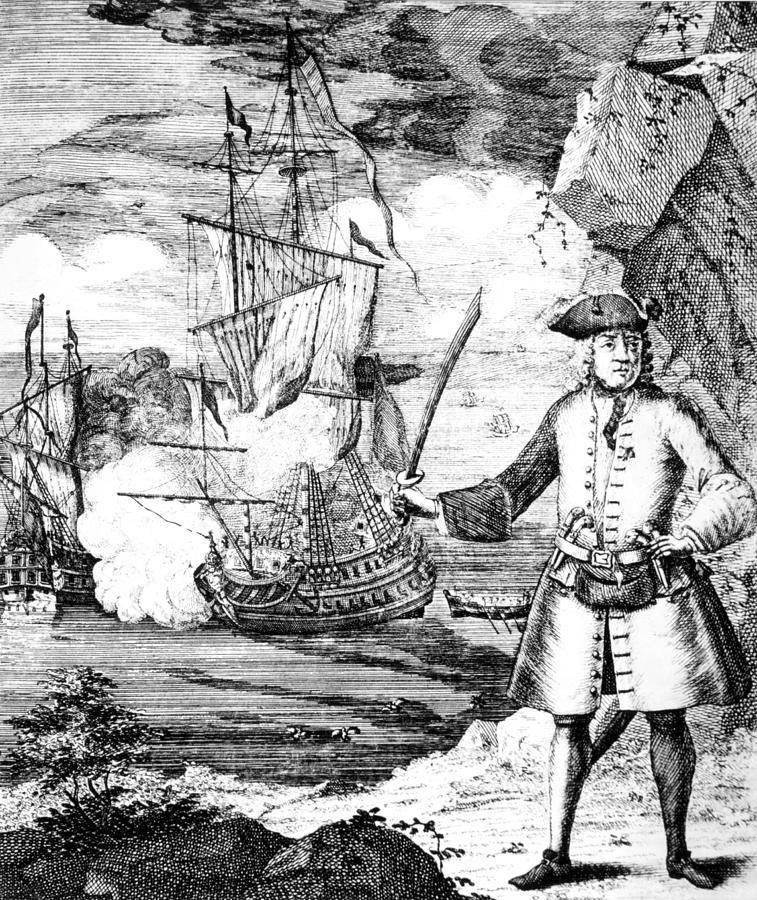
Depiction of Henry Avery with the Fancy battling another ship in the background
While the ship was on the sea, Captain Gibson has awoken and rang his bell, Avery went to his cabin where he found him half asleep. The captain asked what was happening to the ship and were they driven from the anchor by a storm. Avery responded that they were at the sea with good weather and a fair wind. The captain inquired how could that be, and Avery responded: ” Come, don't be in a fright, but put on your clothes, and I'll let you into a secret. You must know that I am captain of this ship now, and this is my cabin, therefore you must walk out; I am bound to Madagascar, with a design of making my own fortune, and that of all the brave fellows joined with me."
The captain was frightened, but Avery assured him that there is nothing to be afraid of and offered him a choice. He could join the crew and become Avery’s lieutenant under the condition that he turns sober and attends to business. Another option was to be given a longboat and go to shore with the rest of the crew who wasn’t willing to join Avery’s cause. Gibson chose the second proposal and only six sailors decided to accompany him. After sending away those unwilling to join the cause, Avery renamed the ship to the Fancy and set sail to Madagascar.
Avery committed his first piracy at Cape Verde’s Sotavento islands. He robbed three English merchant ships and persuaded nine men to join his crew. With his crew numbering close to hundred men Avery continued to sail along the African coast robbing or tricking several other vessels. The Fancy’s next stop was next in Benin where the crew careened and razeed the ship.
Careening the ship is the practice of intentional grounding of the vessel during the high tide in order to expose one side of its hull for maintenance during the low tide. Razeeing of the ship is the practice of cutting it down and reducing the number of the decks on the ship.
After the maintenance and razeeing was completed the Fancy became one of the fastest ships in the world.
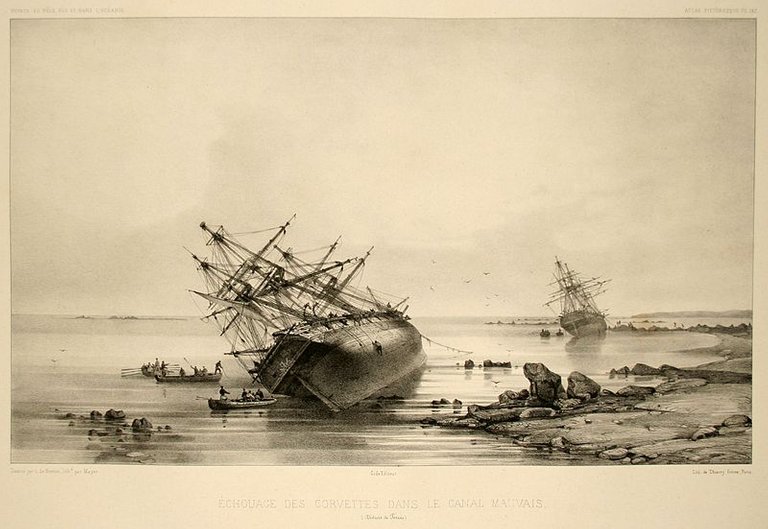
Careening of a ship - Jules Dumont d'Urville (1846)
On the way to Madagascar, Avery robbed many more ships, both merchant and other pirate vessels were his prey. In the process, he increased his crew to 150 men. When he arrived to the northeast part of Madagascar he encountered two sloops at anchor. The crews of the sloops also consisted of deserter sailors and once they noticed the Fancy they ran ashore, thinking it has been sent in pursuit after them. Suspecting their background, Avery sent a few of his men ashore unarmed, their mission was to inform the crews of the sloops that they were friends and propose a union between them. After initial negotiations, Avery himself went ashore and persuaded the men ashore to join forces with his crew.
In August 1695, Avery sailed to the Straits of Bab-el-Mandeb to wait for the Indian fleet that would be returning from the annual pilgrimage to Mecca soon. There he joined forces with a few other pirate captains, who elected Avery the Admiral of the newly formed flotilla. The five other captains of the flotilla were Thomas Wake on Susanna with seventy men; Thomas Tew on the Amity, Joseph Faro on the Portsmouth Adventure, Richard Want on the Dolphin, with sixty men each; and William Mayes on the Pearl with forty men.
The pirate flotilla spotted a convoy of twenty-five Mughal ships sailing towards Surat and gave chase. Five days later, three pirate ships caught up with the ship Fateh Muhammed. The Dolphin was to slow, so the crew joined Avery on board of the Fancy and the other ship was burned. The Susanna and Amity were also slow, and they were left behind. Intimidated by the Fancy’s number of cannons, the Fateh Muhammed’s crew put up almost no resistance. The ship had belonged to Surat’s wealthiest merchant, Abdul Ghaffar. He was so rich that his trade equaled that of East-India Company. Although the ship contained treasure worth around £50000, once the treasure was shared among the great number of pirates each of them received only a small share, so they continued the pursuit.
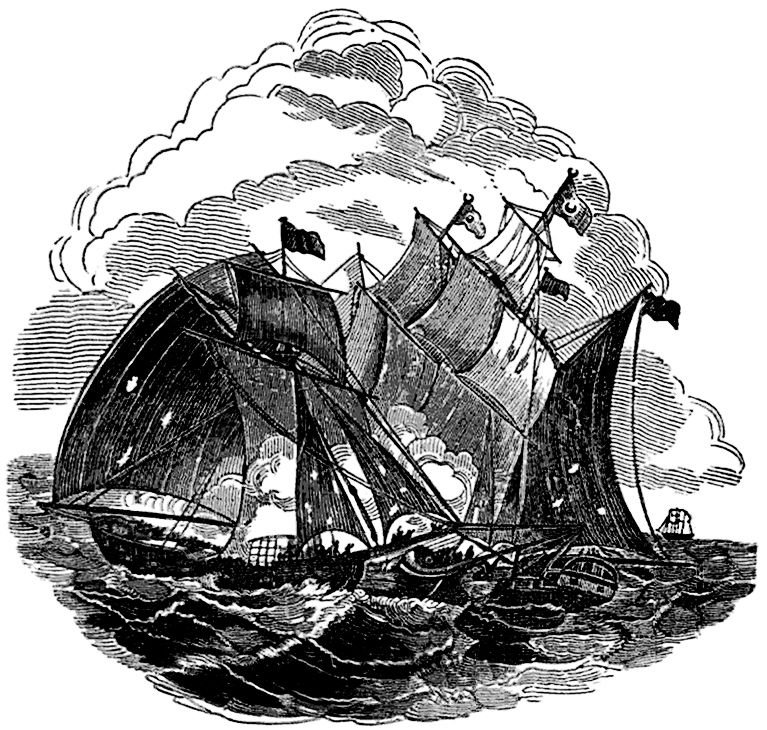
Captain Henry Avery engaging the Ganj-i-Sawai
They finally caught up with the treasure ship of Emperor Aurangzeb, the Ganj-i-Sawai captained by Muhammad Ibrahim. Ganj-i-Sawai was an enormous ship with eighty cannons, weighing 1600 tons. The fearsome Ganj-i-Sawai was manned by a guard of four hundred musket-men and six hundred other passengers. Despite the odds the Fancy engaged the enemy in battle. Avery’s opening volley shot the mainmast by the board preventing the Ganj-i-Sawai from escaping. One of the cannons on the Indian ship exploded killing many of its crew. Avery’s men used the situation to their advantage and boarded the ship. The crew of the Pearl, that was initially too afraid to fight Ganj-i-Sawai, now joined Avery’s men on board of the ship. The resulting hand-to-hand battle lasted for three hours with the pirates emerging victorious. The treasure on the ship was worth around £600000 which equals £52M in today’s value, making this the most lucrative pirate heist in history.
Aftermath
After they divided the treasure, each pirate was left with the amount of money that most sailors didn’t make in their lifetime. The Portsmouth Adventure didn’t partake in the battle, so the crew of that ship didn’t receive any shares. The sources vary on the topic of what happened with the Pearl’s part of the treasure. One source mentions a trade between Avery’s and Mayes’ trade that included clipped coins. The trade resulted in the infuriated crew of the Fancy confiscating the treasure from the Pearl. According to that source, Mayes was given some money to buy resources and the ships parted company. According to the other source, Avery persuaded the other captain to leave the treasure in his care. The Fancy was the stronger ship so he argued that the treasure would be safer there. After all the treasure was on his ship he disappeared under the cover of night. Whichever of the sources is correct, the fact remains that most of the treasure was in Avery’s hands. The crew was aware that they were all hunted men now, and they had to decide what to do next.
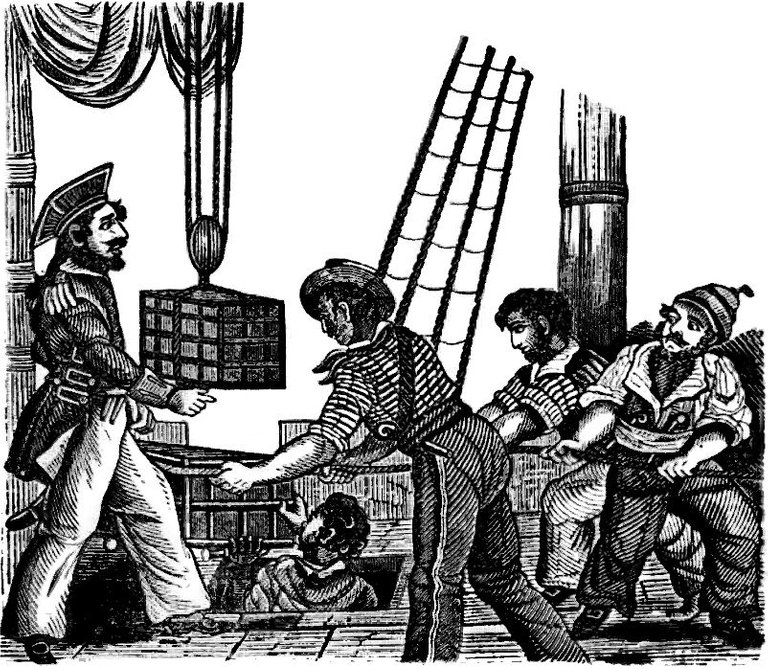
Captain Henry Avery receiving the three chests of Treasure on board of his Ship
The plunder of the Ganj-i-Sawai had consequences for entire England. When the news of Avery’s actions reached Emperor Aurangzeb he was so infuriated that he threatened to close all of the East India Company’s operations and drive out all Englishmen from the Indian subcontinent. He already closed four of the company's factories in India and imprisoned all of their officers before the English Parliament had time to react. He was about to order an attack against English city of Bombay when the English government took actions to appease the Mughal emperor. The East India Company promised to pay all the financial reparations; while Avery was declared enemy of the human race, and £1000 bounty (around £95000 today) was offered for his head. Parliament also offered pardon from all crimes to any person who disclosed his whereabouts; in addition, Avery was to be excluded from all of the amnesties the Crown would subsequently issue to other pirates. Thus began the first worldwide manhunt in history.
While that was happening Avery has already reached Nassau. There, Avery under alias Henry Bridgeman told the island’s governor, Sir Nicholas Trott that he was an illegal slave trader (that was a pretty common crime at the time). He offered a bribe of £860 (an amount that Trott earned in three years with governor’s salary) and promised to give the Fancy as a gift to the governor after his crew unloaded the cargo. It was a good offer for the governor considering that Avery’s crew was larger than the population of the island, and it would prove problematic to the governor if they decided to take over the island.
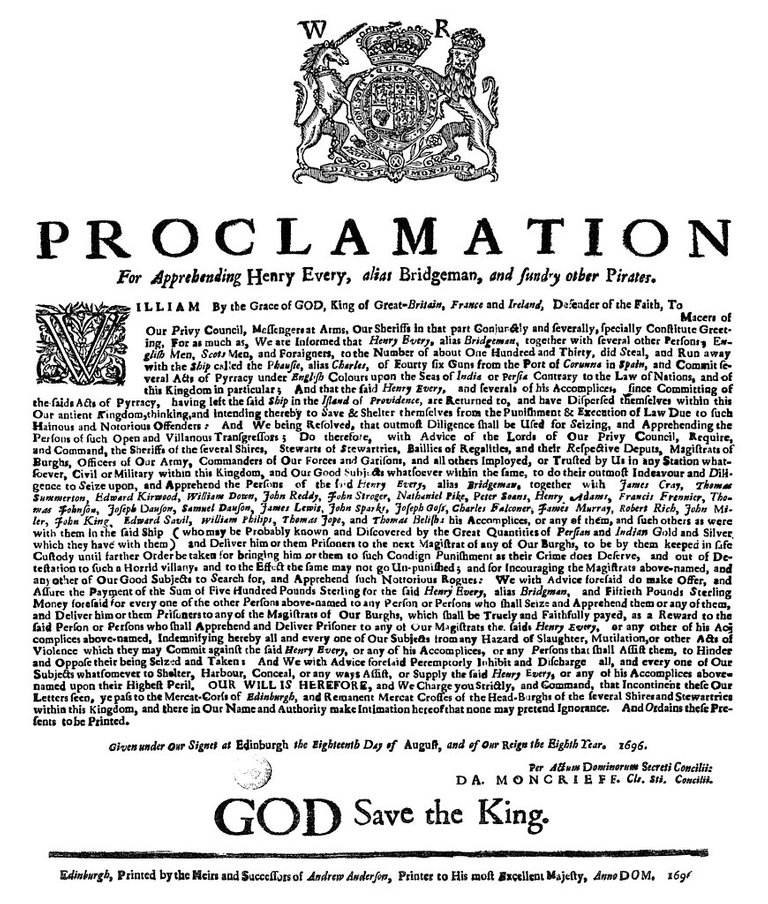
Proclamation for apprehending Captain Henry Every
Once the proclamation for Avery’s arrest reached Nassau, Trott was forced to alert the authorities about Avery’s whereabouts. However, he was able to tip off the pirates before the authorities arrived. Avery told his crew members conflicting stories about his intended destination and vanished never to be seen again; that made Avery one of the rare pirates in history to retire with his treasure without being arrested or killed in battle.
Sources
- A General History of the Pyrates - 1724, Captain Charles Johnson
- The Republic of Pirates: Being the True and Surprising Story of the Caribbean Pirates and the Man Who Brought Them Down - 2007, Colin Woodard
- Wikipedia
Previous post from the series:
I think we just found the plot to the next Pirates of the Caribbean Franchise. Excellent writing, the article kept me intrigued from the very first sentences of the intro, Keep it up! (:
Thanks, sorry I missed your comment, I usually check bottom of the comments for the new ones, and yours ended on top as you voted on it.
For some reason I find it hillarious that he also enslaved the guy that sold him slaves...
He vanished without leaving any trace, that would be so hard in this day and age...
It was hard at that time as well considering that he was wanted throughout the world and that he had a lot of stolen goods to sell. :)
I read all of your trilogy and this is the best one so far.
Thanks for the compliments :)
Oh wow aside from Norse mythology I like reading the swashbuckling adventures of pirates and privateers.
You made this post interesting but still full of knowledge.
Thanks, I love the pirates topic so there will be many more posts about them! 🏴☠️
Another fascinating pirate post. I've read a bit about the pirates who "traded" in the Bahamas, as my father's side of the family is from there. However I've never heard of Henry Avery. The history of Britain and the Bahamas, its former colony, is a very colourful one.
The Bahamas were very popular pirating site. It was a place with lots of traffic and weak defenses at the time, a pirate utopia of sorts! 🏴☠️Avery wasn't really active there so it is no wonder you haven't heard about him while reading about the Bahamas. The Bahamas were more often frequented by "Blackbeard", Rackham, Hornigold and few others.
Thanks for reading and commenting! :D
BEST LINE OF THE WHOLE POST! hahahahahaha
this was amazing!!!! oh my gosh - i loved this one @arrrados :)
Clever people make clever pirates!!!! hmmmm so i think he is my favorite so far - let's see if anyone else can dethrone him from my pedestal!!!
(and I think it is safe to say that since I am Queen of pirates... it's only fitting that I should adore the King of pirates! hahahahaah)
but hmmmmm I am still holding out for your post on the Robin Hood of pirates!!! :)
as always - excellent job!!! :)
I loved that habit of his as well :)
"Robin Hood" will come as a part of a little trilogy of articles within the series.
You will probably love Zhèng Shì Chinese piratess who commanded the largest pirate navy in history and Teuta, Illyrian queen who controlled the Adriatic sea with her pirates! 🏴☠️
yesssssssssssssss.... i will love it!!!!! long live the pirates ;)
What a fascinating story! Avery reaching Nassau made me think of Flint and Blackbeard's stories. I really enjoy reading your posts. Thank you!
Thank you for reading! I will be covering "Blackbeard" soon ;)
Congratulations! This post has been chosen as one of the daily Whistle Stops for The STEEM Engine!
You can see your post's place along the track here: The Daily Whistle Stops, Issue #102 (4/12/18)
The STEEM Engine is an initiative dedicated to promoting meaningful engagement across Steemit. Find out more about us and join us today.